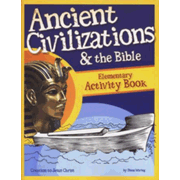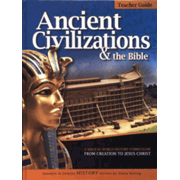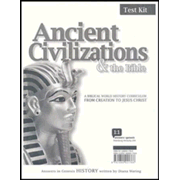Popular convention speaker and storyteller extraordinaire Diana Waring is the author of the History Revealed program. This three-volume history series for students in grades 6 through 12 has a number of features that make it unique. The most prominent feature is that it is a thoroughly Christian approach to history that relies on Scripture almost as much as secular sources for information. Informed by a biblical Christian worldview, it follows a young earth chronology.
Other features that distinguish this series are the incorporation of four learning style approaches within every lesson, audio recordings as a core component, and the presentation of history integrated with other subject areas in a chronological fashion.
The three volumes in the series are titled:
Ancient Civilizations and the Bible
Romans, Reformers, and Revolutionaries
World Empires, World Missions, World Wars
More than just a history curriculum, each course might well serve as a unit study with its coverage of history, geography, cultures, Bible, Bible history, and the fine arts coupled with plenty of work in language arts and even some science. Each course requires a student text, teacher manual, a set of What in the World? audio recordings, a test kit, and a rubrics set. These items are bundled as the Essentials Pack for each course. The Premium Pack for each course adds the elementary activity book, True Tales audio recordings, music recordings, the video "Diana Waring Interviews the 8 Kinds of Smart," and Digging Deeper audio recordings. You can purchase print items with digital audio and video, print items with CDs and a DVD, or all digital files (PDFs, an MP4, and MP3s).
While the curriculum might be used in a conventional classroom, it is ideally suited to families with children of various ages. Many of the suggested activities lend themselves to participation by the entire family. However, an optional Elementary Activity Book for each volume provides activities specifically for children in the elementary grades so the entire family can regularly be working together on the same topics to some extent. They include a variety of Bible stories, coloring pages, craft ideas, science experiments, crossword puzzles, games, songs, and other age-appropriate activities. Supplemental books and videos described in lists of "Resources for Digging Deeper" in each chapter (a mix of secular and Christian resources) can be used to reach a broader age range in the family and to extend lessons. You will definitely want to use one or more of these resources with each unit.
Each course is presented in nine units with four, weeklong lessons or "phases" per unit. Each of the four phases reflects one of four learning style preferences (based on Myers Briggs learning styles). The first week's activities best suit the "Feeler" learning style with listening to history stories on CDs, discussion, and activities that help the student get the "people perspective." The second week appeals to the "Thinker" with more traditional learning methods such as vocabulary drill, timeline, researching, and reporting. Week three provides lots of hands-on work for the "Sensor" learning style with activities such as mapmaking, art projects, cooking, and music appreciation. The fourth week offers many opportunities for creative expression such as creative writing, drama, sculpting, music performance, and conceptual design for the "Intuitor" learning style. On top of learning styles, the curriculum incorporates methods that teach to the three learning modalities: visual, auditory, and kinesthetic (movement or hands-on learning). Obviously, students will each enjoy some activities more than others. However, working through all the learning style activities and having options for visual, auditory, and kinesthetic learning means that all students will have opportunities to learn in ways they learn best at least part of the time.
Following this structure of nine units/four weeks per unit, it should take one school year to complete each volume. However, some families might choose to use more of the activities and take longer than one year to complete each course. It would be almost impossible to complete every suggested activity, so you and your children need to select activities most appropriate for both your situation and their learning needs.
I know that one of the primary questions for parents is, "What does each course cover?" These courses provide thorough coverage of world history from Creation up through the Korean War, going much further in-depth on fewer topics than traditional courses rather than trying to cover all the factual information. The reason for this is that the primary purpose is to develop a biblical perspective in history rather than to accumulate knowledge of names and dates. In the introduction, Diana explains: "A biblical perspective in history means seeing God as central to our understanding. In this curriculum, we do not add a few Hebrew dates into an otherwise typical presentation of history and label it ‘biblical.' Instead, we want to see history from His point of view; to view all of history—all cultures and events—in the light of God's revelation of Himself and of His ongoing redemptive purpose pursued throughout the world's existence" (Ancient Civilizations Teacher's Guide, p. 1x).
Although the courses do not focus on memorizing names and dates, the creation of timelines and the various activities will certainly help impart that knowledge. And because everything is taught in context, students are much more likely to remember what they learn.
The only problem you might run into in terms of history coverage is that if you use one course per year, world history will take three years to complete. The third volume ventures into U.S. History, so you will be able to satisfy at least part of U.S. History requirements. This is neither good nor bad but simply something you need to take it into consideration in your long-range planning. Also, the individual volumes will stand on their own even if you don't have time to complete all three or if you have already studied one of these time periods comprehensively with a worldview approach.
Coverage of art and music appreciation should be sufficient for junior high and equal to half a credit at the high school level. If students tackle numerous art projects in the creative phases of the courses, their work might well qualify for a full credit.
Bible coverage is substantial enough for a course credit for any grade level. Language arts and science receive some coverage but not enough to be complete courses.
Diana's background in and enthusiasm for Protestant missionary efforts is evident throughout the books—most strongly in the third volume. However, especially in Romans, Reformers, and Revolutionaries, she takes a fairly even-handed approach that might even work for Catholics, Orthodox, and others as long as they add other resource books (e.g., on church history) reflecting other viewpoints. Diana addresses early church history, the Church Fathers, Councils, and early missionary efforts. She devotes attention to Eastern Orthodoxy, a subject breezed over in most history texts. She raises key questions in regard to church history that are likely to instigate some thought-provoking research and reporting. What's missing is what is happening in branches of Christianity other than Protestantism after the Reformation.
Course components deserve a little more attention. Student books are hefty, 8.5 x 11" softcover books with well over 300 pages each--427 pages in the third book! Although printed in black-and-white, they include some illustrations (primarily photographs) with professional graphics and layout. Each phase concludes with a "Student Self-Evaluation" that serves as an accountability tool while also reinforcing the week's lesson. These books are consumable since students will complete maps and timelines as well as write in them. So each student needs his or her own book.
Hardcover teacher manuals are absolutely essential. Reduced student pages are surrounded by instructions and additional material for presenting lessons. These courses require a parent/teacher to direct discussions, determine assignments, evaluate student work, and generally be involved in much that goes on. Some lesson material is presented in the student books, but students are expected to glean significant amounts of information from listening to the CD's, internet research, and supplemental reading. All of this is outlined in the teacher manuals.
To reinforce both a grasp of the key concepts and names of people, places, and events, a Test Kit is available for each course. It includes a reproducible test for each unit that requires both essay/brief paragraph answers and identification/matching. Answer keys are included in the Test Kit. However, you might prefer to rely on the new Rubrics Set for each course for evaluation purposes. The Rubrics Set is a 21-page book that you can reproduce for your family or your organization. It has 11 different rubric forms with full explanations. These can be used to evaluate student participation,a research project,a mapping project, an art or music presentation, a cultural or science project, a linguistic or drama presentation, a movement presentation, or a conceptual design presentation. The book explains how and when to use either rubrics or the test kit. The Rubrics Set also includes a handy "Quick Start Guide" chart plus charts showing a basic three-day or five-day lesson plan for a unit.
While only What in the World? audio CDs are essential for each course, there are two additional sets of audio CDs that those with auditory learners might want to use: True Tales and Digging Deeper. The CDs are so good that I would recommend them apart from the curriculum. On all of the CDs, Diane Waring tells intriguing stories about people and events from each time period. For example on one of the True Tales CDs, Diana tells about Attila the Hun, Heinrich Schliemann who discovered the ancient city of Troy, the great Byzantine emperor Justinian, and many other fascinating characters. These are great both for the historical content and for entertainment.
The Essentials Pack for each course includes the student book, the teacher guide, a What in the World? CD set, a Test Kit, a Rubrics Set, and the charts.
The three courses have extra links available on dedicated website pages. Here you will find links to such resources as a Charlotte Mason schedule, links to specific works of art, architecture, and music, and other supplemental helps. Click here for the link for Ancient Civilizations. Click here for the link to the page for Romans, Reformers, and Revolutionaries. For World Empires, World Missions, World Wars click here.
Overall, Diana has created a wonderful history curriculum that is constructed from a biblical worldview. But this won't be for everyone. The curriculum expects children to be making their own choices, researching and working independently quite a bit. This is not a totally teacher-controlled and directed program. The idea is that when students can choose and direct some of their own learning activities they are more likely to be motivated to do a better job. (Material as interesting as Diana's sure helps with motivation!) Parents also have to be willing to allow their children to choose methods and projects that best suit their own learning styles. I believe that the extra effort this type of approach takes is worthwhile if we truly want to help our children develop a love for history as well as an understanding that it is ultimately HIS story that they are learning.



















